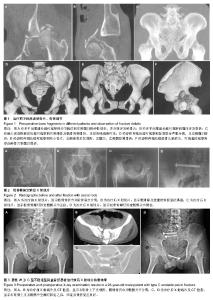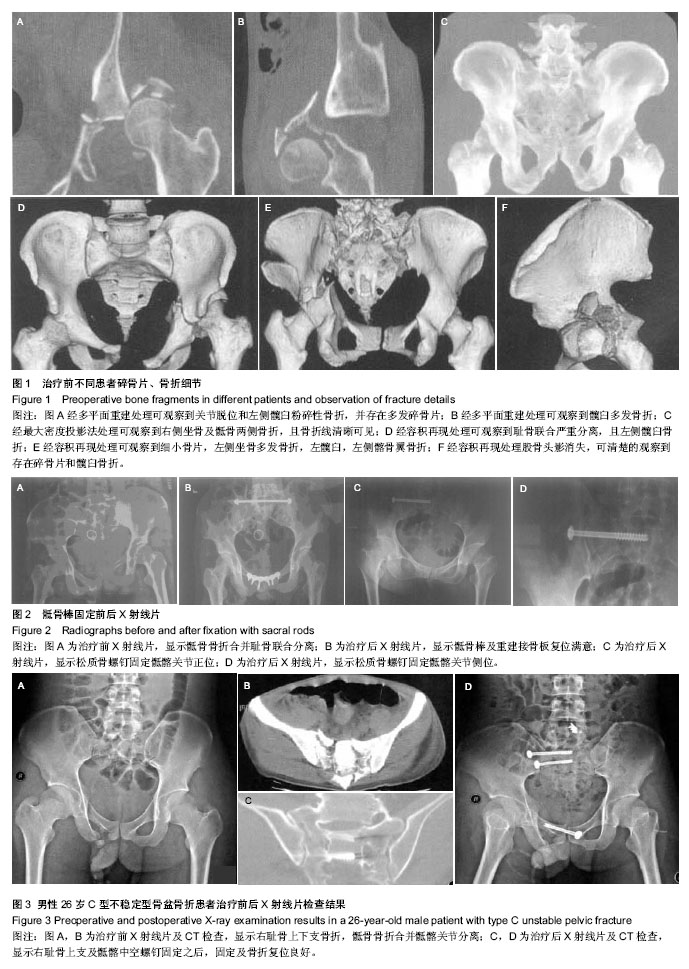| [1] 林志金,曹烈虎,沈锋,等.不稳定型骨盆骨折的金属植入物治疗[J].中国组织工程研究与临床康复,2010,14(9):1665-1668.
[2] 邵建明.不稳定型骨盆骨折的金属植入物治疗[J].北方药学, 2011, 8(8):74-74.
[3] 赵艳.螺钉与钢板在骨盆骨折置入内固定应用中的生物力学评价[J].中国组织工程研究与临床康复,2011,15(48): 9070-9073.
[4] 石成弟,胡炜,余可和,等.不稳定型骨盆骨折三维空间移位的X线诊断方法及其在闭合复位术中的初步应用[J].中华创伤杂志, 2013,29(8):717-722.
[5] 杨彬,李强,谢鸣,等.钢板内固定联合外固定治疗不稳定型骨盆骨折的疗效分析[J].现代预防医学,2011,38(7):1364-1365,1367.
[6] 胡昊,蔡林,金伟,等.外固定架联合髂腰固定术治疗垂直不稳定型骨盆骨折[J].中华骨科杂志,2011,31(1):61-65.
[7] Metsemakers WJ, Vanderschot P, Jennes E. Transcatheter embolotherapy after external surgical stabilization is a valuable treatment algorithm for patients with persistent haemorrhage from unstable pelvic fractures: Outcomes of a single centre experience. Injury. 2013;44(7):964-968.
[8] Cothren CC, Osborn PM, Moore EE, et al. Preperitonal pelvic packing for hemodynamically unstable pelvic fractures: a paradigm shift. J Trauma. 2007;62(4):834-839.
[9] 陶玉平,王静成,冯新民,等.空心拉力螺钉微创内固定治疗不稳定型骨盆骨折的临床疗效研究[J].河北医学,2012,18(7):881-884.
[10] 付晓玲,张湘生,邱睿韫,等.椎弓根螺钉结合外固定支架治疗经骶骨骨折脱位旋转垂直不稳定型骨盆骨折[J].中国现代医学杂志, 2011,21(11):1425-1428.
[11] 陈明,谢鸣,勘武生,等.不稳定型骨盆骨折的手术方式探讨[J].中华创伤骨科杂志,2013,15(5):445-447.
[12] Josef MF, Wolfgang S, Michael Z. The anterior subcutaneous internal fixator (ASIF) for unstable pelvic ring fractures. Clinical and radiological mid-term results. Int Orthop. 2013;37 (11):2239-2245.
[13] 牛志霞,孟庆真.经皮骶骨螺钉固定治疗Tile C1.3型骨盆骨折的护理[J].护士进修杂志,2013,28(15):1381-1382.
[14] 赵山红,高劲谋,胡平,等.严重开放性骨盆骨折损害控制手术策略探讨[J].创伤外科杂志,2014,(1):8-10.
[15] 张平,西永明,常西海,等.经皮空心螺钉内固定治疗骨盆骨折15例临床分析[J].山东医药,2012,52(41):64-66.
[16] 郭远学,成凯,彭磊,等.经皮微创螺钉内固定治疗骨盆骨折局限性探究[J].临床误诊误治,2014,27(1):88-90.
[17] 韦辉贤,兰承林,磨惠君,等.切开内固定和外固定架联合应用治疗Tile C型骨盆骨折临床疗效分析[J].广西医科大学学报,2013, 30(5):763-764.
[18] Latini JM, McAninch JW, Brandes SB, et al. SIU/ICUD Consultation on Urethral Strictures: Epidemiology, Etiology, Anatomy, and Nomenclature of Urethral Stenoses, Strictures, and Pelvic Fracture Urethral Disruption Injuries. Urology. 2013;83(3 Suppl):S1-7.
[19] Toogood P, McDonald E, Pekmezci M. A Biomechanical Comparison of Ipsilateral and Contralateral Pedicle Screw Placement for Modified Triangular Osteosynthesis in Unstable Pelvic Fractures. J Orthop Trauma. 2013;27 (9):515-520.
[20] 高金华,郭晓山,梁清宇,等.基于X线片与CT的不稳定型骨盆骨折3D分型研究[J].中华创伤骨科杂志,2013,15(11):961-966.
[21] 刘岗,辛立文,梁源清,等.经皮骶髂螺钉固定技术与开放技术治疗C型骨盆骨折的疗效比较[J].西部医学,2014,26(8):1046-1048.
[22] 王春龙,赵凡,广东,等.重建钛钢板内固定治疗不稳定性骨盆骨折[J].临床外科杂志,2013,21(2):148-149.
[23] 史强,李旭,吴伟平,等.幼儿不稳定型骨盆骨折的手术治疗[J].中华创伤骨科杂志,2014,16(8):719-721.
[24] 董玉珍,宗海斌,赵红星,等.不稳定骨盆骨折的手术治疗效果及影响因素分析[J].中国美容医学,2012,21(z2):377-378.
[25] 宋世锋,彭磊,肖海涛,等.经皮骶髂螺钉与骶髂关节前方钢板固定治疗不稳定性骨盆骨折的对比研究[J].中华骨科杂志,2011, 31(11):1191-1196.
[26] 李琳.外固定联合有限内固定治疗Tile C型骨盆骨折[J].实用骨科杂志,2014,(7):590-593.
[27] 高朝友.内固定治疗不稳定性骨盆骨折41例临床分析[J].临床和实验医学杂志,2012,11(22):1823,1826.
[28] 张成亮,刘加元,李业成,等.有限切开复位钢板内固定治疗Tile C型骨盆骨折[J].实用骨科杂志,2014,20(6):511-514.
[29] 霍雷,张厚庆,徐步靖,等.经皮骶髂关节螺钉内固定治疗骨盆骨折[J].中国微创外科杂志,2013,13(4):339-342.
[30] 杜天平,李莉.椎弓根内固定系统治疗不稳定C型骨盆骨折围手术期观察与护理[J].现代中西医结合杂志,2014,(17): 1922-1924.
[31] 陈爱民,鹿楠,江曦,等.微创Legacy椎弓根螺钉系统治疗Tile C型骨盆骨折[J].中华创伤杂志,2011,27(9):789-792.
[32] 石成弟,汤骏,胡炜,等.经皮空心螺钉内固定与前路钢板内固定治疗不稳定性骨盆骨折的对比研究[J].中医正骨,2013,25(6): 10-13.
[33] 李山珠,袁锋,张世民,等.不稳定型骨盆骨折的救治及手术治疗[J].中国矫形外科杂志,2012,20(6):485-489.
[34] 徐火荣,徐文强.不同内固定方法治疗骨盆骨折合并骶髂关节脱位的临床疗效比较[J].海南医学,2013,24(8):1194-1195.
[35] 赵瑞林.Tile C型骨盆骨折的手术治疗[J].临床骨科杂志, 2012, 15(4):416-417.
[36] 张增亮,尹芸生,郝东升,等.手术治疗不稳定型骨盆骨折的近期疗效[J].中华创伤骨科杂志,2012,14(11):1005-1007.
[37] 刘莹松,刘家国,赵猛,等.经皮骶髂螺钉治疗不稳定性骨盆骨折[J].实用骨科杂志,2013,19(2):165-167.
[38] 安来昱.切开复位内固定治疗不稳定型骨盆骨折的临床观察[J].中国医师进修杂志,2012,35(8):66-67.
[39] Welk B, Al-Hothi H, Winick-Ng J, et al. The effect of pelvic factures on future stress incontinence and pelvic organ prolapse surgery. Int Urogynecol J. 2015. [Epub ahead of print]
[40] 孟波,孙海钰,李明,等.计算机辅助在骨盆骨折诊断与治疗方面的临床价值[J].中国组织工程研究,2014,(17):2673-2678.
[41] 李乐翔,周东生,王鲁博,等.计算机导航系统置钉结合术中三维CT修复重建骨盆骨折:与传统C臂透视辅助的对比[J].中国组织工程研究与临床康复,2010,14(43):8012-8015.
[42] 张俊平,马建平.骨盆骨折合并后尿道断裂22例临床诊疗分析[J].山西医科大学学报,2014,45(6):508-510.
[43] 岑怡彪,钟华,杨国俊,等.复杂不稳定型骨盆骨折手术治疗的临床分析[J].实用骨科杂志,2013,19(4):358-360.
[44] 刘莹松,张劲松,刘家国,等.骶髂螺钉治疗不稳定型骨盆骨折的疗效分析[J].创伤外科杂志,2013,15(2):119-122. |

